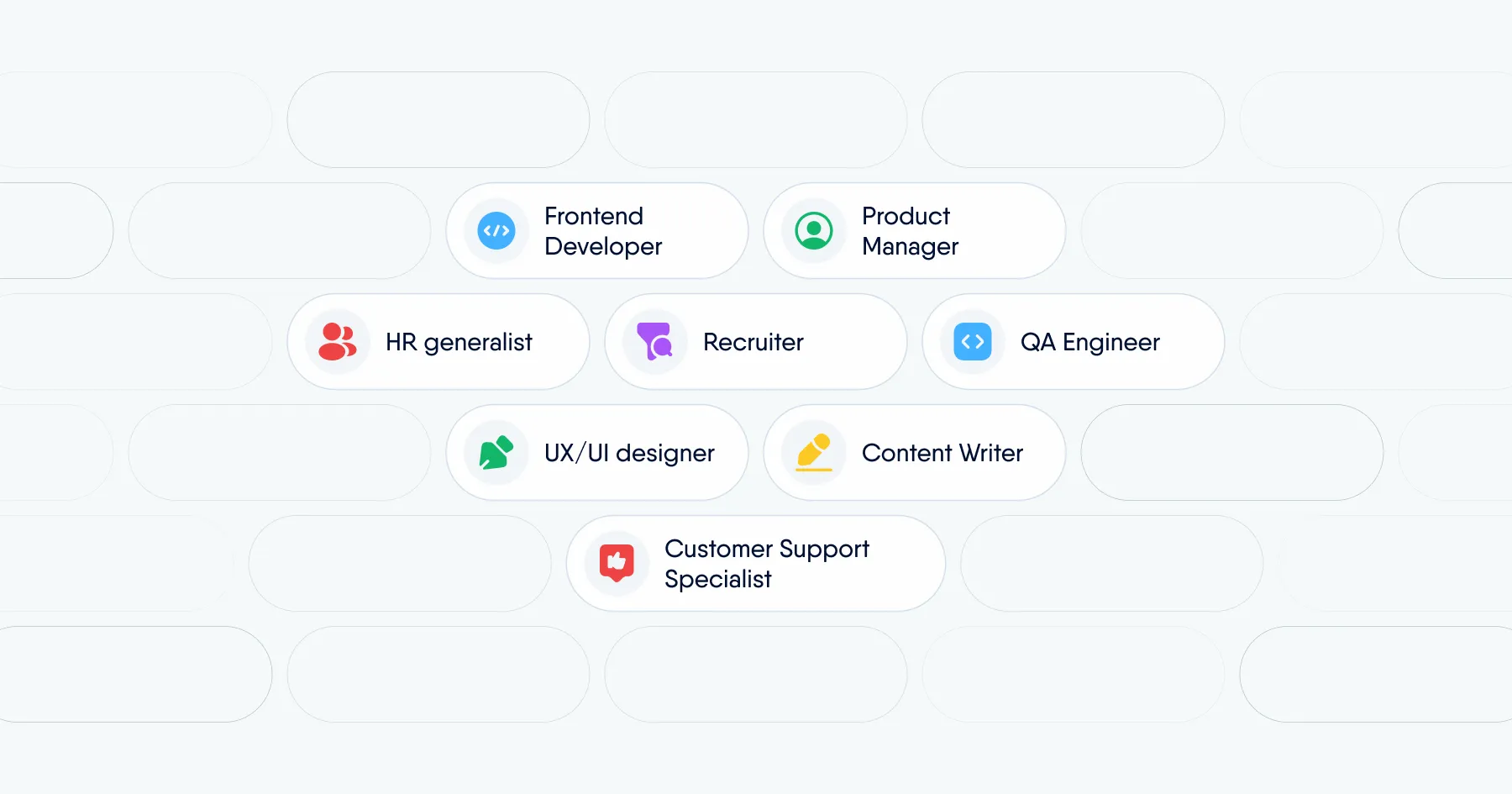Unconscious bias
What is unconscious bias?
What is unconscious bias?
Unconscious bias, also known as implicit bias, refers to the automatic mental associations we form based on experiences, cultural patterns, and everyday observations. These biases influence how we perceive others and the decisions we make. They can manifest as both unwarranted favoritism and unjustified criticism.
In HR, unconscious bias directly impacts processes that should be objective and fair – like initial candidate screening, recruiting, employee evaluations, and promotion decisions.
How does unconscious bias develop?
Unconscious bias often develops as a mental “energy-saving” mechanism. Instead of analyzing each situation from scratch, we rely on ready-made mental shortcuts and associations. While this speeds up decision-making, it also leads to oversimplification and errors.
Several factors shape unconscious bias, including:
- Early experiences and upbringing – what we learn in childhood from family and our environment stays with us and influences how we interpret situations as adults.
- Culture and society – media, language, and stereotypes in public discourse reinforce certain images and beliefs about gender, age, or professional roles.
- Work experience – previous interactions with employees or candidates can unconsciously influence how we perceive future individuals in similar situations.
- Psychological mechanisms – the brain seeks to quickly recognize patterns and simplify information, which promotes mental shortcuts.
- Time pressure and decision fatigue – the less time we have to make decisions, the more likely we are to rely on intuition and stereotypes instead of analyzing facts.
How is unconscious bias different from conscious bias?
While both lead to unequal treatment, they operate through different mechanisms. Conscious bias is deliberate – the decision-maker knows they're favoring one party over another. For example, a manager might intentionally promote an employee who's a friend, despite others having better performance records.
Unconscious bias isn't intentional – quite the opposite. The person displaying it believes they're acting objectively. For instance, a recruiter might consistently select candidates with communication styles similar to their own because they subconsciously view them as better “team fits”, even when other candidates have equal or superior qualifications.
Why addressing unconscious bias matters for HR and business
Unconscious bias affects hiring, performance reviews, and promotions. Left unchecked, it limits access to talent, reduces engagement, and creates workplace inequality. The result? Weakened organizational culture and diminished company performance.
From an HR perspective, reducing unconscious bias leads to better people decisions. Recruitment based on consistent criteria lets you evaluate candidates on actual skills. Performance reviews become fairer and more credible because they're based on measurable results rather than personal preferences or gut feelings. When employees feel they're treated equally, their motivation increases and turnover drops.
From a business standpoint, eliminating bias opens access to a broader talent pool. This helps build strong, diverse teams where different experiences and perspectives make problem-solving easier and responses to change faster. McKinsey research shows that companies prioritizing inclusion are more likely to achieve above-average financial performance.
Bias reduction efforts also strengthen employer brand – organizations that consistently work to minimize bias are recognized as equal-opportunity employers. This attracts top candidates, strengthens current employee loyalty, and increases appeal to customers and business partners.
Examples of unconscious bias in the workplace and ways to reduce their impact
Phenomena like ageism, racial bias, and gender bias can occur both consciously and unconsciously. This article focuses on their unconscious manifestations, which are particularly hard to identify because the person exhibiting them believes they're being objective.
Ageism
Ageism is age-related bias that leads to stereotypical views of older workers as less flexible and younger workers as inexperienced. In recruitment, this might mean overlooking 50+ candidates for tech-related roles or dismissing recent graduates for junior positions. Combating ageism requires evaluating candidates based on skills and performance rather than age, plus implementing mentoring programs that connect different generations.
Halo effect
The halo effect occurs when one positive trait about a candidate – like graduating from a prestigious university – overshadows an objective assessment of their other skills. During recruitment, a hiring manager might inflate a candidate's overall rating based solely on this single factor while ignoring weaker areas. Solutions include using structured evaluation forms where each competency is assessed separately and independently.
Racial bias
Racial bias involves attributing traits and abilities to people from specific ethnic groups based on stereotypes. In recruitment, this shows up as fewer interview invitations for candidates with foreign-sounding names, even when they meet all requirements. Practices that limit such behavior include anonymizing resume data (blind recruitment) and providing training on diversity and equal treatment.
Gender bias
Gender bias manifests as favoring one gender over another—for example, women are less often considered for leadership positions, while men are more frequently credited with ambition and drive. HR processes can address this by monitoring promotions and compensation by gender, using consistent evaluation criteria, and ensuring neutral language in job postings.
Appearance bias
This phenomenon involves evaluating candidates based on physical attractiveness. People considered attractive may be perceived as more competent, while those who don't fit conventional standards may be seen as less professional. In recruitment, this can be limited by eliminating photos from resumes, using competency tests, and focusing on facts rather than appearance.
Nonverbal bias
Nonverbal bias involves judging others based on body language, tone of voice, or facial expressions. In recruitment, this might lead to a candidate who avoids eye contact being labeled as insecure, when their behavior actually stems from stress or cultural differences. These biases can be countered by using structured interview questions, basing evaluations on competency test results, and developing HR teams' knowledge of cross-cultural communication.
Golem effect
The Golem effect occurs when negative expectations about an employee impact their performance and well-being. If a supervisor assumes a new hire "won't cut it," they may not assign challenging projects, which actually leads to weaker results. Limiting this effect involves setting clear goals, providing constructive feedback, and ensuring equal access to development opportunities for everyone.
Confirmation bias
Confirmation bias involves seeking information that supports existing beliefs while ignoring contradictory evidence. In recruitment, this might show up when a recruiter analyzes a resume, decides the candidate "isn't a team fit," and then asks questions solely to prove that assumption. To reduce this effect, use structured interviews and checklists that require evaluating all competencies consistently.
Anchoring bias
Anchoring bias involves placing too much weight on the first piece of information received, such as salary expectations mentioned by a candidate. During compensation negotiations, this figure becomes the reference point, even if the position's salary range is different. The solution is relying on market analysis and internal salary bands rather than just the first number mentioned.
Authority bias
Authority bias is the tendency to place excessive trust in opinions from higher-ranking individuals, regardless of the merit of their arguments. In recruitment panels, this often means a director's opinion determines the candidate evaluation, even when other team members have different observations. To prevent this, consider using anonymous panel voting or giving equal weight to all voices in the process.
Contrast effect
The contrast effect occurs when someone's evaluation depends on how they compare to others. A moderately prepared candidate might receive a better assessment during an interview if they follow someone who performed very poorly. To limit this effect, use a consistent rating scale and take notes immediately after each interview. This makes evaluations more objective and independent of meeting order.
Status quo bias
Status quo bias is the preference for what's familiar and resistance to change. In HR, this shows up as a tendency to promote people similar to current employees rather than reaching for external candidates who bring fresh experiences and different perspectives to the team. Solutions include promoting diversity in recruitment and change management training that helps leaders embrace new approaches.
Primacy effect
The primacy effect means information presented first sticks in memory more strongly than what comes later. In recruitment, this can lead to the first candidate interviewed being rated higher than others, regardless of competency. To reduce this effect, compare candidates only after completing the entire interview process and use a consistent rating scale.
Recency effect
The recency effect is the opposite of the primacy effect. It means the most recent information is remembered most strongly, while earlier details have less impact on evaluation. In recruitment, this means the last candidate interviewed might be rated better simply because their conversation is fresh in the recruiter's memory. To limit this effect, take notes after each interview and compile candidate evaluations only after finishing the entire process.
How HR platforms help reduce unconscious bias in the workplace
One way to reduce unconscious bias in organizations is by using HR tools like HR platforms that introduce standardization and objective evaluation criteria. In PeopleForce, this includes features such as:
Team-based candidate evaluation – each recruitment team member can evaluate candidates independently, and the system combines these ratings into one result. This makes hiring decisions more objective and less susceptible to the halo effect or individual preferences.
Recruitment testing – instead of relying on first impressions or communication style, recruiters can make decisions based on the results of knowledge and skills tests. This gives candidates who truly best match the position requirements a real chance at getting hired.
360° reviews – employees receive feedback not just from supervisors, but also from colleagues and direct reports. This ensures decisions about their development or promotion don't depend solely on one person's opinion and are less vulnerable to individual biases.
Performance indicators – the system allows you to assign weights to different competencies (totaling 100%), then calculates a performance indicator on a 0-100 scale. This means employees are evaluated based on measurable criteria tied to their role.
1:1 meetings – regular, structured conversations between employee and supervisor support open communication and reduce the risk of unfair treatment.
Safe Speak feature – enables employees to safely and anonymously report issues related to discrimination or unequal treatment, building trust and enabling corrective action.
Reporting – HR analytics let you track diversity and compensation metrics, plus quickly identify areas where bias might emerge.
Pulse surveys – regular employee opinion and engagement surveys provide insights into the organizational climate. They help you quickly respond to signals of unequal treatment or team culture problems.
Summary
Unconscious bias doesn't stem from ill will, but it can seriously distort HR decisions in organizations. Addressing it requires more than just education and awareness-building—you also need tools that support objectivity and standardized HR processes. Only their combination allows you to build a work culture based on equality and trust. This environment promotes better work results, higher employee engagement, and stronger employer branding.

